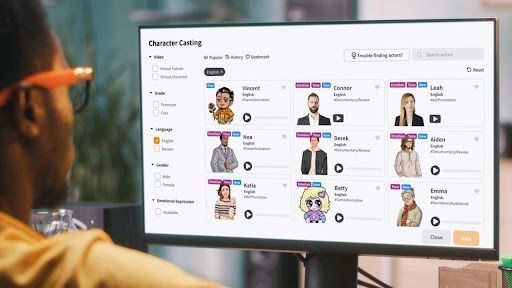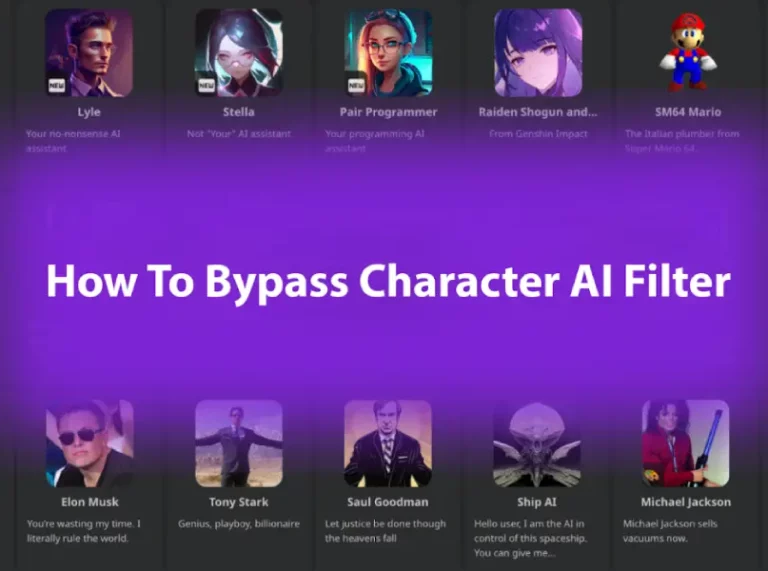How To Make An AI Voice: Empower With Synthetic Speech
Let’s embark on an extraordinary journey of voice creation! “How to Make an AI Voice” unveils the secrets of crafting lifelike synthetic speech!
From advanced techniques to powerful tools, empower your projects with the mesmerizing capabilities of synthetic speech, revolutionizing the way your content engages and attracts audiences.
Find out more details in this article below!
How Many Types Of AI Voice?
In the realm of artificial intelligence (AI), voice technology has witnessed remarkable advancements. AI voice systems have become ubiquitous, enabling various applications ranging from virtual assistants to audiobook narrations.
However, AI voices are not a one-size-fits-all concept. Let’s explore the two types of AI voices and each of their distinctive characteristics.

AI text-to-speech
AI text-to-speech (TTS) technology has revolutionized the way machines generate human-like speech from written text. This type of AI voice involves converting textual content into spoken words.
AI TTS systems utilize deep learning models, such as recurrent neural networks (RNNs) or transformers, to analyze and synthesize speech with natural intonation, rhythm, and inflection. It is widely used in applications like virtual assistants, audiobooks, and voice-overs for multimedia content.
Synthetic AI voice
Synthetic AI voices, generated without relying on human speech data, offer unique and customizable qualities. With a futuristic or robotic touch, its applications can be in video games, animated characters, and IVR systems.
Variations in voice generation techniques include concatenative synthesis (combining pre-recorded speech segments), parametric synthesis (manipulating acoustic parameters), and unit selection synthesis (concatenating small speech units). These types of AI voices facilitate innovative uses, empowering developers, businesses, and users to leverage synthetic speech effectively.
How To Make An AI Voice?
Interested in creating your very own AI voice? Discover the fascinating world of AI voice creation in two ways with the steps and techniques involved that can add a unique touch to your projects.
Convert text to voice
Converting text to voice, also known as text-to-speech (TTS), allows you to transform written content into spoken words. Here’s a simple step-by-step guide to help you perform this process:
Step 1: Choose a text-to-speech system
First, let’s explore available TTS systems that suit your needs. Consider factors like language support, voice quality, and customization options.
Step 2: Input text
To have a text or content to input the AI voice, plan and prepare the text you want to convert into speech. It can be a document, a web page, or simply a text file.
Step 3: Select voice parameters
Some TTS systems offer customization options like voice pitch, speed, and accent. Select and adjust these parameters according to your preferences or requirements.

Step 4: Configure speech settings
In this step, determine your desired format, such as audio file type (MP3, WAV, etc.), encoding options, and desired output quality.
Step 5: Initiate text-to-speech conversion
This is the time to choose a TTS system or software to input your text and initiate the conversion process.
Step 6: Review and edit
After conversion, hear again your generated speech and make any necessary adjustments. Some TTS systems may provide post-processing options to refine the output.
Step 7: Save or share the generated speech
After all, the last step is to save the converted speech as an audio file or use direct integrations with other applications for seamless sharing or playback.
By following these steps, you can easily convert text to AI voice, opening up possibilities for audiobooks, voiceovers, accessibility tools, and more.
We suggest experimenting with different TTS systems to find the one that best suits your needs and enhances the overall quality of your text-to-voice conversions.
Create a synthetic voice
Creating a synthetic voice involves a combination of advanced techniques and tools. Here’s a step-by-step guide to help you navigate the process of crafting your synthetic voice:
Step 1: Data collection
In the first step, gather a diverse set of high-quality audio recordings from a chosen voice talent to serve as the foundation for your synthetic voice.
Step 2: Preprocessing
Clean and preprocess the audio data to remove background noise, normalize volume levels, and segment into smaller units for better manipulation.
Step 3: Feature extraction
Extract relevant acoustic features from the preprocessed audio, such as pitch, duration, and spectral characteristics, to capture the unique characteristics of the voice.
Step 4: Voice model training
Utilize machine learning algorithms, like deep neural networks, to train a voice model using the extracted acoustic features as input.
Step 5: Text-to-speech synthesis
Implement a text-to-speech synthesis system that incorporates your trained voice model. This system should be able to generate speech from input text using the learned voice characteristics.
Step 6: Fine-tuning and evaluation
Continuously fine-tune the synthetic voice model based on feedback and evaluate its quality using objective metrics and subjective listening tests.
Step 7: Integration and application
Finally, integrate your synthetic voice into the desired application or platform, whether it’s for virtual assistants, voiceover work, or other interactive systems.
By following these steps and iteratively refining the process, you can not only create a compelling synthetic voice that meets your specific requirements but also add a touch of uniqueness to your projects.
Do Any Challenges Of Creating AI Voice?
Besides some fantastic benefits, creating AI voices like real voices presents a range of challenges that span data collection, voice generation techniques, and ethical considerations.
From acquiring diverse and high-quality datasets to addressing privacy concerns, navigating these challenges is crucial for developing realistic and ethical AI voices.

AI training
One of the primary challenges in creating AI voices lies in the training process. Training AI models for voice synthesis requires a vast amount of high-quality audio data, making acquiring diverse and representative datasets that cover various linguistic patterns, accents, and speech characteristics a daunting task.
Additionally, training deep learning models for voice synthesis demands significant computational resources and expertise in optimizing model performance.
Choose the right AI voice generator
Different AI voice generation techniques, such as concatenative synthesis, parametric synthesis, and unit selection synthesis, have their advantages and limitations.
Choosing the most suitable approach depends on factors like voice quality, flexibility, customization options, and the specific requirements of the project.
Concern about privacy
Creating AI voices raises concerns about privacy and ethical considerations. For example, voice cloning technology can potentially be misused for impersonation or other malicious activities.
It is essential to address these concerns by ensuring appropriate consent and permissions are obtained before using someone’s voice for AI voice synthesis. Respecting user privacy and safeguarding personal data is of paramount importance to maintaining trust in AI voice technology.
So, by addressing these challenges through rigorous data collection, advanced AI training techniques, a responsible choice of voice generators, and ethical considerations, if creators can overcome these hurdles, they will complete an AI voice that is both technically impressive and ethically sound.
Conclusion
Mastering the process of how to make an AI voice empowers projects with synthetic speech, offering flexibility and customization.
By harnessing these new advancements, businesses, and individuals can create compelling auditory experiences, captivate audiences, and enhance user interactions across various domains.
FAQ
- Is there a free AI Voice generator?
Yes, there are free AI voice generators available, but they may have limitations in terms of voice options, benefit restrictions, or quality. One example of a free AI voice generator is Google’s Text-to-Speech (TTS) API.
- Can AI generate a natural-sounding speech?
Yes, AI has made significant advancements in creating realistic voice and generating natural-sounding speech. State-of-the-art AI models can produce speech that closely resembles human voices, with proper intonation, rhythm, and expressiveness.
- Is it legal to use AI voices?
The legality of using AI voices depends on various factors, such as the terms and conditions set by the AI voice provider, the intended usage, and any applicable copyright or intellectual property laws. It’s essential to ensure proper permissions, licenses, and adherence to legal guidelines when using AI voices.








